Dragging Core2Duo into 2013: Time for an Upgrade?
by Ian Cutress on January 15, 2013 12:30 PM EST- Posted in
- CPUs
As any ‘family source of computer information’ will testify, every so often a family member will want an upgrade. Over the final few months of 2012, I did this with my brother’s machine, fitting him out with a Sandy Bridge CPU, an SSD and a good GPU to tackle the newly released Borderlands 2 with, all for free. The only problem he really had up until that point was a dismal FPS in RuneScape.
The system he had been using for the two years previous was an old hand-me-down I had sold him – a Core2Duo E6400 with 2x2 GB of DDR2-800 and a pair of Radeon HD4670s in Crossfire. While he loves his new system with double the cores, a better GPU and an SSD, I wondered how much of an upgrade it had really been.
I have gone through many upgrade philosophies over the decade. My current one to friends and family that ask about upgrades is that if they are happy installing new components. then upgrade each component to one of the best in its class one at a time, rather than at an overall mediocre setup, as much as budget allows. This tends towards outfitting a system with a great SSD, then a GPU, PSU, and finally a motherboard/CPU/memory upgrade with one of those being great. Over time the other two of that trio also get upgraded, and the cycle repeats. Old parts are sold and some cost is recouped in the process, but at least some of the hardware is always on the cutting edge, rather than a middling computer shop off-the-shelf system that could be full of bloatware and dust.
As a result of upgrading my brother's computer, I ended up with his old CPU/motherboard/memory combo, full of dust, sitting on top of one of my many piles of boxes. I decided to pick it up and run the system with a top range GPU and an SSD through my normal benchmarking suite to see how it faired to the likes of the latest FM2 Trinity and Intel offerings, both at stock and with a reasonable overclock. Certain results piqued my interest, but as for normal web browsing and such it still feels as tight as a drum.
The test setup is as follows:
Core2Duo E6400 – 2 cores, 2.13 GHz stock
2x2 GB OCZ DDR2 PC8500 5-6-6
MSI i975X Platinum PowerUp Edition (supports up to PCIe 1.1)
Windows 7 64-bit
AMD Catalyst 12.3 + NVIDIA 296.10 WHQL (for consistency between older results)
My recent testing procedure in motherboard reviews pairs the motherboard with an SSD and a HD7970/GTX580, and given my upgrading philosophy above, I went with these for comparable results. The other systems in the results used DDR3 memory in the range of 1600 C9 for the i3-3225 to 2400 C9 for the i7-3770K.
The Core2Duo system was tested at stock (2.13 GHz and DDR2-533 5-5-5) and with a mild overclock (2.8 GHz and DDR2-700 5-5-6).
Gaming Benchmarks
Games were tested at 2560x1440 (another ‘throw money at a single upgrade at a time’ possibility) with all the eye candy turned up, and results were taken as the average of four runs.
Metro2033
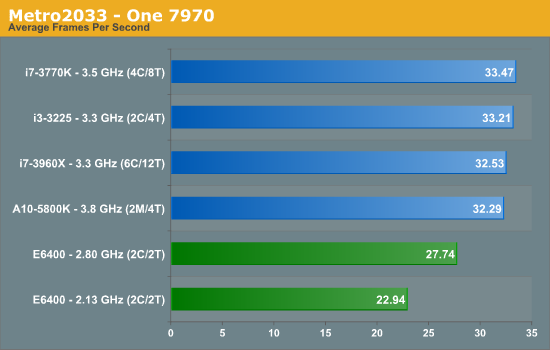
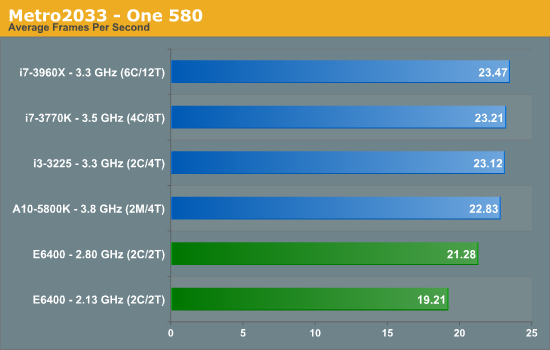
While an admirable effort by the E6400, and overclocking helps a little, the newer systems get that edge. Interestingly the difference is not that much, with an overclocked E6400 being within 1 FPS of an A10-5800K at this resolution and settings while using a 580.
Dirt3
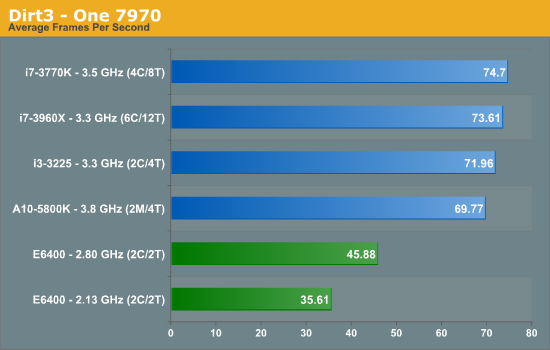

The bump by the overclock makes Dirt3 more playable, but it still lags behind the newer systems.
Computational Benchmarks
3D Movement Algorithm Test
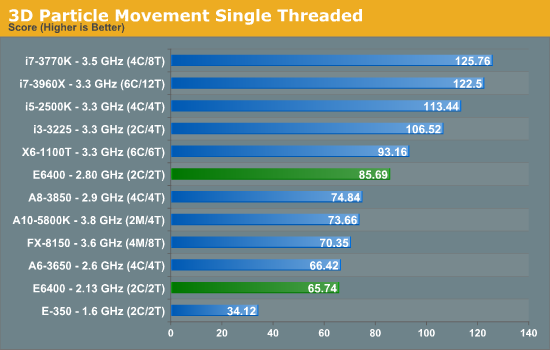
This is where it starts to get interesting. At stock the E6400 lags at the bottom but within reach of an FX-8150 4.2 GHz , but with an overclock the E6400 at 2.8 GHz easily beats the Trinity-based A10-5800K at 4.2 GHz. Part of this can be attributed to the way the Bulldozer/Piledriver CPUs deal with floating point calculations, but it is incredible that a July 2006 processor can beat an October 2012 model. One could argue that a mild bump on the A10-5800K would put it over the edge, but in our overclocking of that chip anything above 4.5 GHz was quite tough (we perhaps got a bad sample to OC).
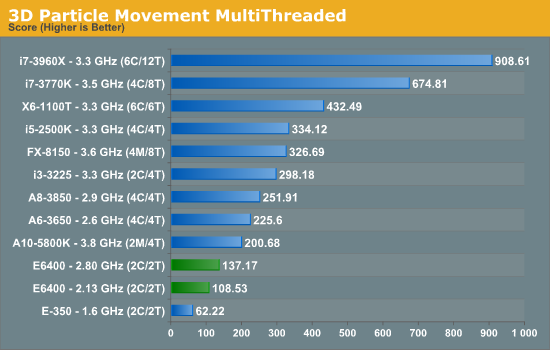
Of course the situation changes when we hit the multithreaded benchmark, with the two cores of the E6400 holding it back. However, if we were using a quad core Q6600, stock CPU performance would be on par with the A10-5800K in an FP workload, although the Q6600 would have four FP units to calculate with and the A10-5800K only has two (as well as the iGPU).
WinRAR x64 3.93 - link

In a variable threaded workload, the DDR2 equipped E6400 is easily outpaced by any modern processor using DDR3.
FastStone Image Viewer 4.2 - link
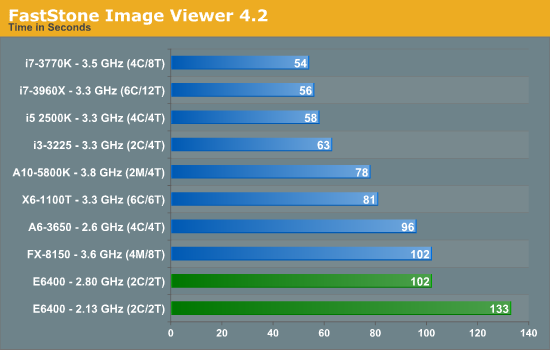
Despite FastStone being single threaded, the increased IPC of the later generations usually brings home the bacon - the only difference being the Bulldozer based FX-8150, which is on par with the E6400.
Xilisoft Video Converter
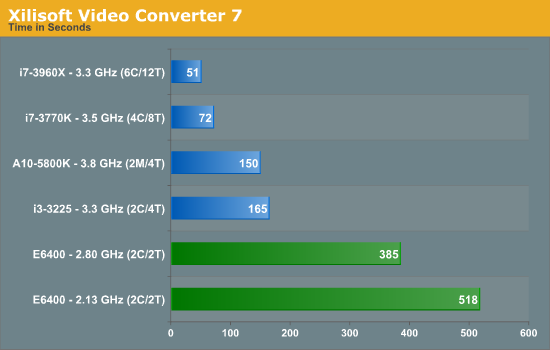
Similarly with XVC, more threads and INT workloads win the day.
x264 HD Benchmark
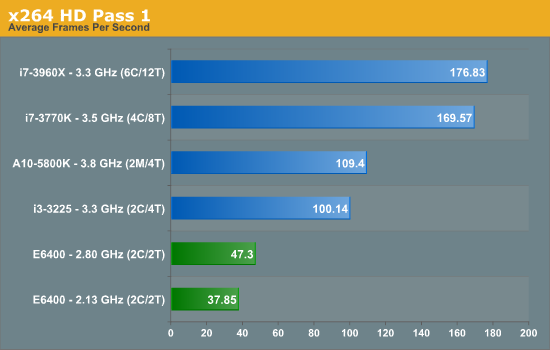
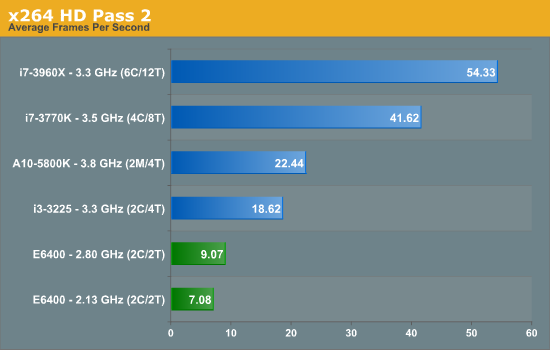
Conclusions
When I start a test session like this, my first test is usually 3DPM in single thread mode. When I got that startling result, I clearly had to dig deeper, but the conclusion produced by the rest of the results is clear. In terms of actual throughput benchmarks, the E6400 is comparatively slow to all the modern home computer processors, either limited by cores or by memory.
This was going to be obvious from the start.
In the sole benchmark which does not rely on memory or thread scheduling and is purely floating point based the E6400 gives a surprise result, but nothing more. In our limited gaming tests the E6400 copes well at 2560x1440, with that slight overclock making Dirt3 more playable.
But the end result is that if everything else is upgraded, and the performance boost is cost effective, even a move to an i3-3225 or A10-5800K will yield real world tangible benefits, alongside all the modern advances in motherboard features (USB 3.0, SATA 6 Gbps, mSATA, Thunderbolt, UEFI, PCIe 2.0/3.0, Audio, Network). There are also significant power savings to be had with modern architectures.
My brother enjoys playing his games at a more reasonable frame rate now, and he says normal usage has sped up by a bit, making watching video streams a little smoother if anything. The only question is where Haswell will come in to this, and is a question I look forward to answering.


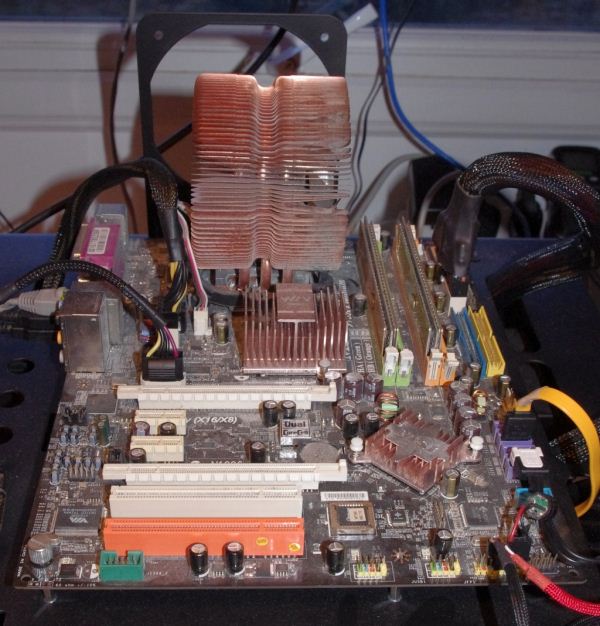








136 Comments
View All Comments
MrSpadge - Tuesday, January 15, 2013 - link
One could measure maximum and average latencies between "sending task out" and "finished". It's a tough job to select meaningful benchmark scenarios suitable to such measurements and to interpret that data carefully. Anyway, pioneering work could be done here.ImSpartacus - Wednesday, January 16, 2013 - link
Yup, I'm going to keep my 3.6GHz E8400 for a little longer now. I thought it would significantly bottleneck if I put a decent GPU alongside it, but now I know they I can get 95% of the potential gaming performance with this high clocked CPU.Alucard291 - Thursday, January 17, 2013 - link
Well I daresay this (fairly poor by Anand's standards) "review" shows that actually the ANCIENT E6400 is still good enough for most people.And that there is barely any reason to upgrade. But yeah all them "modern advances" which are once again only very arguably useful... (thunderbolt? really? UEFI? for your family's pc? USB 3.0 is also pretty pointless atm)
In the end a pointless review. Ancient cpu's are a bit slower than new ones. Well yeah? We all knew that.
This sort of a review is better suited for... idk? Engadget?
IanCutress - Saturday, January 19, 2013 - link
It's one thing to know, another to actually publish results in a testing environment to show the difference. Oh right, but you already knew. Then why bother reading, surely it's a waste of your time?For the record, my father and grandfather already take advantage of USB 3.0, with my father moving his band music around and the grandfather with his veteran meets. Stick in some WiDi for less cables, or a simple UEFI so if something goes wrong I can tell them what to do over the phone with a lot less hassle.
This is despite the fact that I'm upgrading my brother's computer here and testing his old one. He plays a lot of games, he watches a lot of paintball streams and often does both across two monitors at the same time. As stated, he feels a benefit, and the numbers in the regular testing can at least quantify that to some degree based on the upgrade methodology listed.
Ian
Alucard291 - Saturday, January 19, 2013 - link
So why didn't you show the full range of tests?Or was it simply a matter of being too lazy? OR is it as I said above "they didn't fit your predetermined conclusion"?
ESPECIALLY if you say that these are your standard tests (which they are yes).
So why not run the whole suite?
So yep, engadget quality content.
don_k - Thursday, February 7, 2013 - link
Also upgrading to something soon from a e8200 at 4.2Ghz :) With a 580, gaming is no issue at good frame rates. An upgrade is certainly due, however.wreckeysroll - Sunday, February 17, 2013 - link
just move from my Q6600 to 3570. Was a great upgradewerfu - Tuesday, January 15, 2013 - link
Your bench shows it clearly: most Core 2 owner, especially owners of E8xxx or Q9xxx can still hang onto their rig and upgrade their GPU and get and SSD for an overall speed-up. The DDR2 may limit the performance, but it's not like kits of low-timing DDR2-1066 aren't availables and may provide better performance than generic DDR3-1333. And there's lot of second hand socket 775 CPU and motherboard (some DDR3), which may provide an incentive to fix instead of replace.Death666Angel - Tuesday, January 15, 2013 - link
Hm, halving the time it takes to unpack a .rar or doubling/tripling/quadrupling the time of my encodes is not a trivial thing. If all you do is game and use word, maybe hanging on to the old stuff is good. But I think this shows the benefits of upgrading quite clearly.I'd love to see something similar done with the CPU I have (3.8GHz i7 860). I'm holding off on upgrading that for Haswell if I have the money then, don't want to upgrade to a dead platform again. :D
Hubb1e - Tuesday, January 15, 2013 - link
Actually I think you've got it backwards. doubling/tripling/quadrupling the time of encodes isn't a big deal at all to me and I'd guess most people. They spend MUCH more time gaming than bootlegging ripped DVDs or the occasional re-encode of a video file to youtube. A few more minutes to finish an encode isn't a big deal to most people, yet if they can't get playable framerates on Diablo 3 or Sim City then they need to upgrade. It's about whether or not their computer can run their apps rather than how fast they are. If a game is a slideshow then it is unplayable, if you encode at 3 fps then you still get it done, it just takes longer. It all depends on the applications that you run. If you run only office tasks and the internet, then even my parent's single core Sempron 140 feels snappy working in Word, taking out red eye from a photo, or even with web video because the 780G graphics accelerates it.